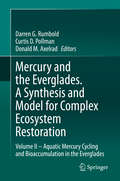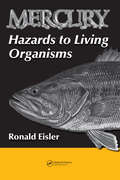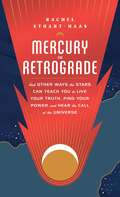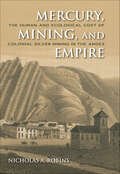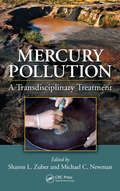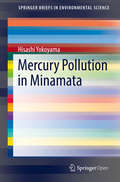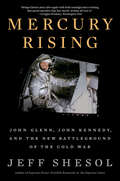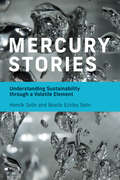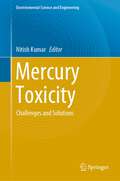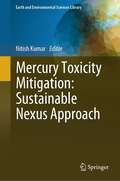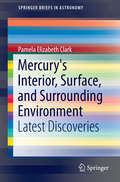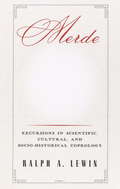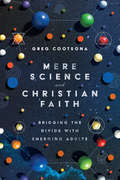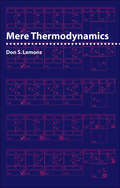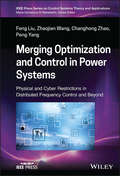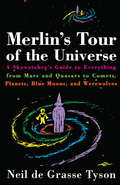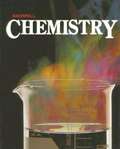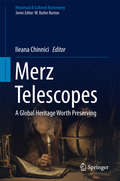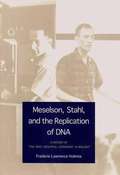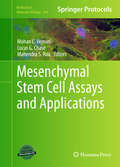- Table View
- List View
Mercury and the Everglades. A Synthesis and Model for Complex Ecosystem Restoration: Volume II – Aquatic Mercury Cycling and Bioaccumulation in the Everglades
by Darren G. Rumbold Curtis D. Pollman Donald M. AxelradThis book integrates 30 years of mercury research in the Florida Everglades to inform scientists and policy makers. The Everglades is an iconic ecosystem by virtue of its expanse; diversity of biota; and multiple international designations. Despite this, the Everglades has been subjected to multiple threats including: habitat loss, hydrologic alterations, invasive species and altered water quality. Less well recognized as a threat to Everglades human use and wildlife populations is the toxic metal, mercury. The first half of Volume II focuses on biogeochemistry and factors unique to the Everglades that make it extraordinarily susceptible to mercury methylation following its deposition: warm subtropical climate, shallow depth, high levels of dissolved organic matter, sulfate contamination, nutrient enrichment and sediment redox conditions (for review of atmospheric mercury deposition significance, see Vol. I). The second half of Volume II answers the “so what” question – why biomagnification of the methylmercury produced in the Everglades is a threat to the health of top predators including humans. The results of the synthesis presented in Volume II suggest that the mercury problem in the Florida Everglades is one of the worst in the world due to its areal extent and the degree of risk to ecological receptors and humans.
Mercury and the Sun (Planet Guides)
by Duncan BrewerHave you ever wondered where Mercury gots its name? What causes Solar Flares? Or Solar Winds? Or what are Sun Spots exactly? Learn the answers to these and other interesting questions in this simple read introductory book to Mercury and the Sun. You will learn about Mercury's composition, the different layers of the Sun and much more. Worth a look for any star gazers.
Mercury and Venus (World Book's Solar System and Space Exploration Library)
by Al SmuskiewiczIntroduction to Mercury and Venus, providing to primary and intermediate grade students information on their features and exploration. Includes fun facts, glossary, resource list and index.
Mercury (Exploring the Solar System)
by Giles SparrowWhat would it be like if you could travel to Mercury in a spaceship, land on its surface, and bound around in the low gravity? This book takes you on a mission to Mercury. Fly over the second-largest impact crater in the solar system, explore the deep cracks in Mercury's crust, and find out why a day lasts longer than a year on this tiny planet.
Mercury Hazards to Living Organisms
by Ronald EislerComplex and ever changing in its forms and functions, the element mercury follows a convoluted course through the environment and up the food chain. The process is complicated further by the fact that the difference between tolerable natural background levels and harmful effects in the environment is exceptionally small and still not completely und
Mercury in Retrograde: And Other Ways the Stars Can Teach You to Live Your Truth, Find Your Power, and Hear the Call of the Universe
by Rachel Stuart-HaasFrom lunar logic to retrograde real talk, eclipses to asteroids, practicing astrologer Rachel Stuart-Haas breaks down the astrological phenomena that impact your day-to-day life in this giftable guide to the heavens, and what they have in store. The sun, moon, stars, and other celestial bodies are constantly impacting our lives. They affect our decision making, relationships, communication. They signal change and grant us moments of self-reflection. And, if we let them, they challenge us to grow into the best versions of ourselves. In Mercury in Retrograde, practicing astrologer Rachel Stuart-Haas takes us on a fun and energizing exploration of the astrological phenomena that guide our lives. Unpacking eclipses, retrogrades, the major and minor aspects, asteroids, and moon wisdom, Stuart-Haas teaches readers how to go beyond their zodiac sun sign and natal chart (how the stars were aligned at their birth) and start thinking like a real astrologer to: -Align their energies with the Universe -Time major life decisions to auspicious moments -Improve their relationships, mental health, and well-being -Create meaningful rituals for self-care -And more! Perfect for armchair astrologists, fans of divination, and anyone looking to improve their relationships, mental health, and overall wellbeing, this wise, delightful, and easy-to-read book provides the first step to reclaiming your life and accomplishing all you&’ve ever dreamed of.
Mercury, Mining, and Empire: The Human and Ecological Cost of Colonial Silver Mining in the Andes
by Nicholas A. RobinsOn the basis of an examination of the colonial mercury and silver production processes and related labor systems, Mercury, Mining, and Empire explores the effects of mercury pollution in colonial Huancavelica, Peru, and Potosí, in present-day Bolivia. The book presents a multifaceted and interwoven tale of what colonial exploitation of indigenous peoples and resources left in its wake. It is a socio-ecological history that explores the toxic interrelationships between mercury and silver production, urban environments, and the people who lived and worked in them. Nicholas A. Robins tells the story of how native peoples in the region were conscripted into the noxious ranks of foot soldiers of proto-globalism, and how their fate, and that of their communities, was—and still is—chained to it.
Mercury Pollution: A Transdisciplinary Treatment
by Sharon L. Zuber Michael C. NewmanCRCHow does mercury get out of the ground and into our food? Is tuna safe to eat? What was the Minamata Disaster? Mercury Pollution: A Transdisciplinary Treatment addresses these questions and more. The editors weave interdisciplinary threads into a tapestry that presents a more complete picture of the effects of mercury pollution and provides new way
Mercury Pollution in Minamata (SpringerBriefs in Environmental Science)
by Hisashi YokoyamaThis book is open access under a CC BY 4.0 license. It overviews the poisoning which occurred in the 1950s and 1960s among the residents in Minamata who ate seafood contaminated with methylmercury discharged from the chemical factory, Chisso Corporation. It describes the history, symptoms pathogenesis and research on the causal agent, and discusses the responses of Chisso and the national and local governments to the outbreak, the victims, the compensation and environmental restructuring as well as the court ruling on claims. Based on lecture notes from a university course, it includes students’ suggestions for avoiding a repeat of the tragedy. The issue has not been settled yet, and this analysis of the incident provides useful insights into solutions to the current global mercury pollution problem.
Mercury Rising: John Glenn, John Kennedy, And The New Battleground Of The Cold War
by Jeff ShesolOne of the Washington Post's 20 Books to Read This Summer A riveting history of the epic orbital flight that put America back into the space race. If the United States couldn’t catch up to the Soviets in space, how could it compete with them on Earth? That was the question facing John F. Kennedy at the height of the Cold War—a perilous time when the Soviet Union built the wall in Berlin, tested nuclear bombs more destructive than any in history, and beat the United States to every major milestone in space. The race to the heavens seemed a race for survival—and America was losing. On February 20, 1962, when John Glenn blasted into orbit aboard Friendship 7, his mission was not only to circle the planet; it was to calm the fears of the free world and renew America’s sense of self-belief. Mercury Rising re-creates the tension and excitement of a flight that shifted the momentum of the space race and put the United States on the path to the moon. Drawing on new archival sources, personal interviews, and previously unpublished notes by Glenn himself, Mercury Rising reveals how the astronaut’s heroics lifted the nation’s hopes in what Kennedy called the "hour of maximum danger."
Mercury Stories: Understanding Sustainability through a Volatile Element
by Henrik Selin Noelle Eckley SelinAn interdisciplinary analysis of human interactions with mercury through history that sheds light on efforts to promote and achieve sustainability.In Mercury Stories, Henrik Selin and Noelle Eckley Selin examine sustainability through analyzing human interactions with mercury over thousands of years. They explore how people have made beneficial use of this volatile element, how they have been harmed by its toxic properties, and how they have tried to protect themselves and the environment from its damaging effects. Taking a systems approach, they develop and apply an analytical framework that can inform other efforts to evaluate and promote sustainability.
Mercury Toxicity: Challenges and Solutions (Environmental Science and Engineering)
by Nitish KumarThis book presents mercury toxicity with respect to remediation and health issues. It covers sources of mercury contamination, its impact on human health, and prospective remediation by both bioremediation and phytoremediation with the application of recent advanced techniques such as genetic engineering and nanotechnology.Both anthropogenic activities and natural processes cause the release of mercury into different spheres of the environment resulting in severe adverse impacts. Increased anthropogenic discharge of mercury leads to disturbance in its natural biogeochemical cycle, which results in unenviable diseases and hazardous health effects. Mercury pollution is responsible for causing neurobehavioral, kidney, heart, gastrointestinal, liver, and other diseases. Many published works about the impact of mercury on health are also available worldwide; however, there is no complete understanding available on toxicological studies of mercury that covers the broader spectrum of findings ranging from sources of exposure to mercury toxicity to its remediation strategies.This book brings together a diverse group of environmental science, sustainability, and health researchers to address the challenges posed by global mass poisoning caused by mercury contamination. The book also proposes solutions to contamination through multi-disciplinary approaches.The book contains three sections. The first part describes the different sources and distribution of mercury in soil and plant ecosystems. The second part explains the health risks linked to mercury toxicity. The third part addresses sustainable mercury toxicity mitigation strategies and the potential applications of recent technology in providing solutions. This book is a valuable resource to students, academics, researchers, and environmental professionals working in the field of mercury contamination.
Mercury Toxicity Mitigation: Sustainable Nexus Approach (Earth and Environmental Sciences Library)
by Nitish KumarMercury is a naturally occurring element that is toxic in nature. According to the US Environmental Protection Agency, the safe limit of mercury ion in drinking water is 10 nM to avoid the serious health problems to humans. Mercury is a pollutant of global concern. Both anthropogenic activities and natural processes cause its release into different spheres of the environment resulting in severe adverse impacts. Increased anthropogenic discharge of mercury leads to disturbance in its natural biogeochemical cycle which results in to unenviable diseases and hazardous health effects.This book will provide state-of-the-art information to the graduate students training in toxicology, risk assessors, researchers and medical providers at large. Many monographs, book chapters, contemporary reviews, and peer reviewed articles about mercury health impact are also available worldwide. However, there is no complete understanding available on toxicological studies of mercury, which covers the broader spectrum of findings that range from sources of exposure to mercury toxicity as well as its remediation strategies. It is aimed to bring the readers updated information about the sources of mercury contamination, and its impact on human health and on prospective mitigation strategies through multi-disciplinary approaches. The book contains three sections. First section describes the different sources and distribution of mercury in the environment. Second section explains the health risks linked to mercury poisoning. Third section addresses sustainable mercury toxicity mitigation strategies through multi-disciplinary approaches. The key topic of this book will cover following: •Source and distribution of mercury in the environment•Effects and responses of mercury toxicity in plants• Health risk linked to mercury poisoning• Sustainable mercury toxicity mitigation strategiesThis book is a valuable resource to students, academics, researchers, and environmental professionals doing field work on mercury contamination throughout the world.
Mercury's Interior, Surface, and Surrounding Environment
by Pamela Elizabeth ClarkThis SpringerBrief details the MESSENGER Mission, the findings of which present challenges to widely held conventional views and remaining mysteries surrounding the planet. The work answers the question of why Mercury is so dense, and the implications from geochemical data on its planetary formation. It summarizes imaging and compositional data from the terrestrial planet surface processes and explains the geologic history of Mercury. It also discusses the lack of southern hemisphere coverage. Our understanding of the planet Mercury has been in a transitional phase over the decades since Mariner 10. The influx of new data from the NASA MESSENGER Mission since it was inserted into the orbit of Mercury in March of 2011 has greatly accelerated that shift. The combined compositional data of relatively high volatiles (S, K), relatively low refractories (Al, Ca), and low crustal iron, combined with an active, partially molten iron rich core, has major implications for Mercury and Solar System formation. From a scientist at NASA Goddard Space Flight Center, this presents a comprehensive overview of the discoveries from the ten-year MESSENGER mission.
Merde
by Ralph A. LewinMerde is an unusual (very unusual) and witty investigation into a subject you may always have wondered about--but didn't know quite what to ask. History, biology, anthropology, culture, animal behavior--all of these are the real subjects of Merde. Why can some animals do it on the run, and others can't? Why does camel dung make good fires? What are the fascinating stories of the dung beetles? Myths and legends, physical features, health and disease, uses for construction and as fertilizers--even nutritional values!--Ralph Lewin writes about them all in the most ingratiating and sophisticated and yet scientific way. Merde is also full of personal adventures and observations, as well as anecdotes and examples. The scattered literature on this subject is voluminous, but until now no one has perused and compiled it all and given it a personal touch, so to speak. It will be hard not to talk about this treasure trove of a book after you've finished it--or perhaps even when you're in the middle of it.From the Hardcover edition.
Mere Science and Christian Faith: Bridging the Divide with Emerging Adults
by Greg CootsonaMany Christians have been brought up under the assumption that mainstream science is incompatible with genuine Christian faith—so when they see compelling evidence for biological evolution, for example, they feel forced to choose between science and their faith. The devastating effects of this dilemma are plain to see, as emerging adults either leave the faith or shut themselves off to the findings of the scientific community. But it's a false dilemma. In this book, Greg Cootsona argues against the idea that science and faith are inherently antagonistic. We don't have to keep them scrupulously separated—instead, we can bring them into dialogue with one another. Cootsona brings this integration to a number of current topics in science and faith conversations, including hermeneutics, the historical Adam and Eve, cognitive science, and the future of technology. His insights are enhanced by his work with Fuller Seminary's STEAM research project. Emerging adults want to believe that science and faith can coexist peacefully. Mere Science and Christian Faith holds out a vision for how that integration is possible and how it can lead us more deeply into the conversations around science and faith that confront the church today.
Mere Thermodynamics
by Don S. LemonsPresenting classical thermodynamics as a concise and discrete whole, Mere Thermodynamics is a perfect tool for teaching a notoriously difficult subject.Accomplished teacher Don S. Lemons introduces the physical theory's concepts and methods and uses them to solve problems from a broad range of physics. He illustrates, at a gentle pace, not only the fundamentals of the subject but also advanced topics such as the relationship between the second law of thermodynamics and entropy. He highlights the intellectual structure and history of the discipline and explores the logical consequences of each of the famous three laws. Lemons explains and develops the first two laws and their corollaries, the methods and applications of thermodynamics, and the third law, as well as non-fluid variables, equilibrium and stability, and two-phase systems.The book features end-of-chapter practice problems, an appendix of worked problems, a glossary of terms, and an annotated bibliography.
Mere Thermodynamics
by Don S. LemonsAn accessible exploration of a notoriously difficult subject, this &“gem of physics pedagogy . . . should be required reading for all courses on thermodynamics&” (Robert C. Hilborn, University of Texas at Dallas). Presenting classical thermodynamics as a concise and discrete whole, Mere Thermodynamics is a perfect tool for teaching the theory&’s central concepts and methods. The book features end-of-chapter practice problems, an appendix of worked problems, a glossary of terms, and an annotated bibliography. Accomplished teacher Don S. Lemons uses thermodynamics to solve problems from a broad range of physics. He illustrates not only the fundamentals of the subject but also advanced topics such as the relationship between the second law of thermodynamics and entropy. He highlights the intellectual structure and history of the discipline and explores the logical consequences of each of the famous three laws. Lemons explains and develops the first two laws and their corollaries, the methods and applications of thermodynamics, and the third law, as well as non-fluid variables, equilibrium and stability, and two-phase systems.
Merging Optimization and Control in Power Systems: Physical and Cyber Restrictions in Distributed Frequency Control and Beyond (IEEE Press Series on Control Systems Theory and Applications)
by Zhaojian Wang Changhong Zhao Feng Liu Peng YangMerging Optimization and Control in Power Systems A novel exploration of distributed control in power systems with insightful discussions of physical and cyber restrictions In Merging Optimization and Control in Power Systems an accomplished team of engineers deliver a comprehensive introduction to distributed optimal control in power systems. The book re-imagines control design within the framework of cyber-physical systems with restrictions in both the physical and cyber spaces, addressing operational constraints, non-smooth objective functions, rapid power fluctuations caused by renewable generations, partial control coverage, communication delays, and non-identical sampling rates. This book bridges the gap between optimization and control in two ways. First, optimization-based feedback control is explored. The authors describe feedback controllers which automatically drive system states asymptotically to specific, desired optimal working points. Second, the book discusses feedback-based optimization. Leveraging the philosophy of feedback control, the authors envision the online solving of complicated optimization and control problems of power systems to adapt to time-varying environments. Readers will also find: A thorough argument against the traditional and centralized hierarchy of power system control in favor of the merged approach described in the book Comprehensive explorations of the fundamental changes gripping the power system today, including the increasing penetration of renewable and distributed generation, the proliferation of electric vehicles, and increases in load demand Data, tables, illustrations, and case studies covering realistic power systems and experiments In-depth examinations of physical and cyber restrictions, as well as the robustness and adaptability of the proposed model Perfect for postgraduate students and researchers with the prerequisite knowledge of power system analysis, operation, and dynamics, convex optimization theory, and control theory, Merging Optimization and Control in Power Systems is an advanced and timely treatment of distributed optimal controller design.
Merlin's Tour of the Universe
by Neil De TysonMerlin, a fictional visitor from the Andromeda Galaxy, Planet Omniscia, has been friends with many of the most important scientific figures of the past including Kepler, da Vinci, Magellan, Doppler, Einstein and Hubble. In this delightful tour of the galaxies, Merlin often recounts his conversations with these historical figures in his responses to popular astronomy questions asked by adults and children alike. Merlin's well-informed answers combine a unique combination of wit and poetry along with serious science explained in refreshingly clear, reader-friendly language.Dear Merlin: Can a person cross our galaxy in a spaceship during one human lifespan?Merlin: In 1905, Merlin's good friend Albert Einstein introduced the "Special Theory of Relativity," which predicts that time will tick slower and slower the faster you travel. Were you to embark on such an adventure you could conceivably age as little as you wish, depending of course, on your exact speed. The problem arises when you return to Earth, which will have moved several hundred thousand years into the future and everyone will have forgotten about you.A skywatcher's book for lovers of the universe by one of its greatest lights.From the Trade Paperback edition.
Merrill Chemistry
by Robert C. Smoot Richard G. Smith Jack Price Tom RussoEach chapter of Merrill CHEMISTRY is organized to keep you centered on the topic at hand. The next few pages describe the many features of this book that will help you understand the exciting world of chemistry.
Merrill Physical Science
by Marilyn Thompson Charles W. Mclaughlin Richard G. SmithMerrill Physical Science will help you understand science principles and recognize their applications to everyday life.
Merz Telescopes: A global heritage worth preserving (Historical & Cultural Astronomy)
by Ileana ChinniciThis book comprisesa fascinating collection of contributions on the Merz telescopes in Italy that collectivelyoffer the first survey on historical large refracting telescopes in the country,drawing on original documents and photographs. It opens with a generalintroduction on the importance of Merz telescopes in the history of astronomyand analyses of the local and international contexts in which the telescopes weremade. After examination of an example of the interaction between the maker andthe astronomer in the construction and maintenance of these refractors, thehistory of the Merz telescopes at the main Italian observatories in the nineteenthcentury is described in detail. Expert testimony is also provided on how thesetelescopes were successfully used until the second half of the twentieth centuryfor research purposes, thus proving their excellent optical qualities.
Meselson, Stahl, and the Replication of DNA: A History of "the Most Beautiful Experiment in Biology"
by Frederic Lawrence HolmesIn 1957 two young scientists at the California Institute of Technology performed an experiment that provided convincing evidence that DNA replicates in the manner predicted by the model of the double helix proposed four years earlier by James Watson and Francis Crick.
Mesenchymal Stem Cell Assays and Applications
by Mohan C Vemuri Lucas G. Chase Mahendra S. RaoMesenchymal Stem Cells have seen an unprecedented level of interest in the last decade, primarily due to their relative ease of isolation, the large numbers of cells present in the adult, and the ability to propagate these cells in culture. In Mesenchymal Stem Cell Assays and Applications, expert researchers from across the globe explore the latest techniques to propagate, characterize, and engineer this special cell type. Chapters outline a set of protocols and assays used by leading investigators in the field, providing standards that can be applied by all researchers to the population of cells used in their experiments. Composed in the highly successful Methods in Molecular BiologyTM series format, each chapter contains a brief introduction, step-by-step methods, a list of necessary materials, and a Notes section which shares tips on troubleshooting and avoiding known pitfalls. Ground-breaking and current, Mesenchymal Stem Cell Assays and Applications is a necessary handbook for all researchers working with this ambiguous population of cells.
